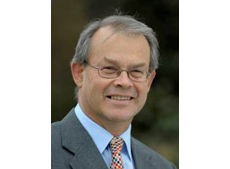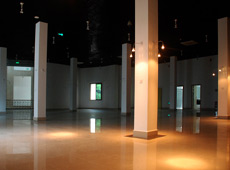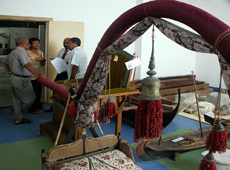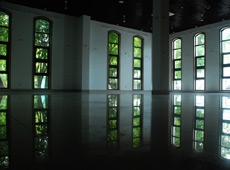President Mohamed Nasheed’s energy advisor Mike Mason has unveiled the technical and economic justification for transforming the Maldives into a solar-powered nation.
“I have the oily rag job,” said the former mining engineer, speaking at Soneva Fushi’s Slow Life Eco Symposium about the government’s ambition to generate 60 percent of the country’s electricity needs through solar. “It’s a bit like trying to build a complex aircraft while the captain’s trying to fly it.”
Last year the Maldives spent 16 percent of its GDP on fossil fuels, making the country staggeringly vulnerable to even the tiniest oil price fluctuations and adding an economic imperative to renewable energy adoption.
Mason evaluated available renewable alternatives to diesel and concluded that solar was the most abundant, cost-effective and realistic resource to exploit.
“We can forget ocean currents for now,” he said, explaining that as the currents were wind driven and therefore seasonal, marine current generators would only generate significant electricity for half the year.
Ocean thermal was “very exciting”, Mason observed, although he noted that Soneva Fushi bore the scars of a failed ocean thermal project: “I suggest we wait for someone else to pioneer this,” he said.
Biomass generation “fits us rather well”, as even if the most expensive form of biomass was imported from Canada it would represent 50-66 percent the current cost of diesel.
“It is cheap but can only be used at scale, such as Male’ and possibly Addu,” he said.
Wind and solar
That left wind and solar, the potential for which was “fascinating”.
The challenge with wind, however, was that it was inconsistent, and there were large periods of the year with little resource available.
“What do you do in the eight months without enough wind?” Mason asked, displaying wind data collected in the country’s north.
“What you do is put up solar. In that case, why bother to put up wind at all? With solar the sun rises every day – it is wonderfully predictable.”
The trick was going to be to transform solar from a green, niche, “subsidy hungry creature, to something so obvious that the current government of the time sees it as a sensible and intelligent thing to do. The reality is that it is easy to get to 30-40% emission reduction, but getting beyond first stage to the 80-90 percent that has been proposed by cabinet will be more difficult.”
Mason collected data concerning the cost of generating electricity using diesel at 100 of the country’s inhabited islands, “as I felt there was not enough data available”, and found staggering levels of inefficiency.
The numbers, he said, “are really scary. At best it costs 28-29 cents to produce a kilowatt hour, but at the top right of the graph it is costing 77 cents per kilowatt hour. Anything beyond 28-29 cents for a big island and 32-33 cents for a small island is just money being burned.”
The Maldives could quickly and easily save US$0.5-1 million dollars a month “simply by fixing power stations by doing boring, sensible stuff.”
“Diesel engines are designed to work at their rated power – they like going flat out. The moment you back off by half, you end up with a less efficient engine. Many islands have power stations with engines out of proportion to the size of the island’s energy needs – in some cases they are running at 15-25 percent capacity. That is a real cost we have.”
Mason then displayed a graph detailing the cost of providing solar, and observed that the cost plummeted quickly when it came to providing 30-40 percent of the country’s energy needs but sharply increased thereafter to a point where it was less competitive.
The challenge, he explained, was storage – how to retain electricity to operate devices such as lights, fridges and air-conditioners at night.
“Energy storage is the big hole in our story here. The key for me is to reach that 80 percent goal without the [cost] graph rising beyond where it is today,” Mason explained.
Using data detailing the energy use patterns of the island of Maalhos in Baa Atoll, Mason observed a high variability in power demand. Introducing solar without storage – “from panel to fridge” – would complicate that by requiring more flexibility from the existing power plant.

“Stick a solar panel on [Maalhos] and you can generate 29kw at midday with zero demand [on the powerplant]. But the maximum you need from the powerplant [without solar] is 42kw. This is a fundamental problem – the more solar you get, the more we have to get the power stations right.”
The cost of providing solar electricity straight from the panel was far below the cost of using diesel on any island, including Male’. On Maalhos, by pointing the solar panel in the same direction all day, “you can meet midday demand easily. But between 6-11 am in the morning, and after 2pm in the afternoon, you still need to meet the cooling load of fridges and air-conditioners.”
Mason had two suggestions – the first was to use (more expensive) tracking solar panels that would follow the sun and extend the daytime period in which demand could be met using solar. This would also generate the maximum yield from each panel, mitigating another problem – space.
“The challenge will be getting tracking to work in a hot, humid, salty environment,” he acknowledged, particularly if the panels were mounted in shallow lagoons.
The cost of providing electricity from solar in conjunction with current commercially available battery technology was not much different from existing diesel arrangements on many islands, Mason observed. “You lose 20 percent of the electricity putting it in and taking it back out, and it is expensive to fix. It’s not good enough.”
However on Maalhos, Mason noted, 28 percent of the electricity demand was for cooling.
“I had a think about storage. We could use really cold water refrigerated during the day, and use that to drive air-conditioning and fridges at night. This applies as much to resorts as it does home islands.”
This innovation would drop the cost to the level of the country’s most efficient diesel generators, Mason explained. For those powerplants currently running at 77 cents a kilowatt, “this is an opportunity to print money – and there aren’t many of those available to the government.”
Challenges
The major problem was obtaining the capital, Mason said, estimating that such an overhaul for the nation would cost US$2-3 billion, “although half of that would come from the tourist industry.”
“With renewable energy, on day 1 you buy 25 years of electricity. It might be cheap, but you still need enough cash on day 1.”
Attracting the investment in a country such as France or Germany would be “a no brainer”, Mason said, however because of the Maldives turbulent political history and fiscal deficit, it had a very weak credit rating.
“There is a shortage of knowledge and skills as well,” he said. “We need an energy technology support unit, and an energy finance corporation that can for this project provide guarantees and get countries to underwrite us. We do not want to be reliant by subsidies.”
In response to a question regarding the planned Gaafaru wind farm, Mason acknowledged the build, own and operate agreement STELCO had signed with Chinese wind turbine manufacturer XEMC to develop a 50mw wind farm at Gaafaru was a potential commercial pressure for adopting solar.
Under this agreement, a backup liquefied natural gas (LNG) plant would also be built, capable of providing up to 30 megawatts on windless days, or when there is not enough wind to meet demand.
Minivan News raised concerns in an article published in April 2010 that according to figures published in a 2003 report by the US National Renewable Energy Laboratory (NREL), North Malé Atoll had an annual average wind speed of 4.9 m/s (17.7 km/h), while a 2005 report by the American Wind Energy Association (AWEA) described the minimum average wind speed needed to run a utility-scale wind power plants as 6 m/s (21.6 km/h).
Mason described the contract as crafted with “more enthusiasm than technical involvement”, and noted that an LNG plant put out 92 percent of the emissions of a diesel plant “of the kind that STELCO already run very well.”
“A single cycle gas turbine of the kind described is very efficient but does not have the flexibility [required]. There is a technical challenge. We need to think about how we integrate things before we sublet the parts, so my instinct is that the contract will not be enacted in form presented.”
Speaking of the solar plan, now backed at least by data if not the finance, a senior government official remarked that the plan to turn to solar was “no longer froth. There’s a shot of espresso in the cappuccino now.”
The Maldives has meanwhile become the first country to crowdsource its renewable energy plan on the internet.
Forum topics in the comprehensive crowdsourcing project include solar and wind technology, energy storage, system control and demand management, novel technologies (including marine current and ocean thermal), biomass power generation, and finance.
Under each topic the Maldives appeals for expert assistance on several technical questions, around issues such as the use of solar panels in corrosive environments, the economics of tracking or fixed solar panel systems, and the viability of low velocity wind turbines.
Visit the forum (English)
 (0)Dislikes
(0)Dislikes (0)
(0)

